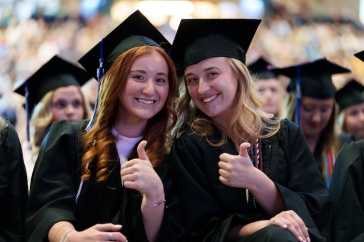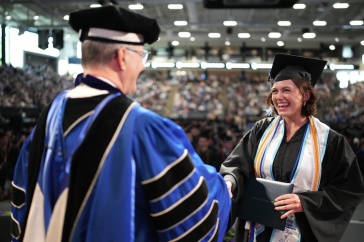
Brent Bell, associate professor of recreation management and policy, teaches students outdoors instead of his classroom due to COVID-19.
During the 2020 spring semester, when the coronavirus shut down the UNH campus, Brent Bell had to figure out how to keep teaching his wilderness first responder course, which typically includes trips to the White Mountains and students hiking into College Woods to find “injured patients.”
Bell, an associate professor of recreation management and policy, describes the class as “very hands-on.” In the past, the College Woods scenario had students encountering individuals with fake injuries that students then assessed and treated. But COVID-19 changed that: College Woods and local roads stood in for the White Mountains. Hands-on became hands off.
That left Bell having to adapt. It helped that back in February, before the campus went remote, he was able to teach his class the basics of patient assessment, providing students with a strong set of skills. This semester they just needed to evaluated patients. But how to do that amid a pandemic? Enter Zoom and Bell’s plan to utilize students’ family members; he assigned them ailments that students then treated over video.
“It worked well. In a few cases, I heard from parents about how impressed they were by the skills their son or daughter had learned,” Bell says. “It was great to be able to share their learning with to them because I was Zooming into their living space and using those closest to them to reinforce their learning.”
Bell also made a number of videos with the help of his own family and a graduate student and her husband.
“I created a scenario where a plane carrying identical triplets to a triplet convention crashes in the woods. That way I was able to use each person in our house as three different patients,” he says. “I also created other video scenarios and then used Zoom breakout rooms for students to work on diagnosing problems.”
Then this fall, when campus reopened and most students returned to in-person learning, Bell adapted again. At high risk medically, he needed to find a way to do that safely without entering a classroom. His idea? Throw away the PowerPoint slides.
“I went back to outdoor lectures,” he says, noting he has been holding class at the outdoor classroom behind James Hall, T-Hall lawn and the outdoor patio at the Whittemore Center. “Instead of PowerPoint, we are doing a lot with sidewalk chalk and dry erase markers. I have a white board with me wherever I go. At night I use the headlight on my bike; it’s bright enough for students to see the board. Overall, I have adapted and I'm having a great semester with this group of students.”
Deborah Kinghorn, professor of acting/voice/movement, was on sabbatical when the coronavirus sent students home last semester, so her adjustment started when she returned this fall along with students. If wilderness training is hands-on and had to be modified, how do you teach students to sing, to act and dance during a pandemic?
You get creative.
"They are very careful in our rehearsals and very cognizant of concerns that others might have. It’s actually been really impressive and reinforced to me just how terrific our students are."
“My teaching depends on being able to hear and see students performing. In person, we were, of course, masked, and we distanced. This was not conducive to partnering work, like scene study, nor was it helpful for hearing and seeing them as we worked on vocal technique,” Kinghorn says. “The flip side would be to have everyone online so they could unmask. But producing the kind of tone needed for good projection is not compatible with microphone work, as it tends to overload the mic, which then simply cuts out.”
And having students wear masks in the audition class would have diminished performances too greatly for them to be effective, she says. That’s where students perform monologues, expressing anger, hysteria, laughter or despair. To protect everyone, Kinghorn had performers spaced at least 10 feet from the rest of the class and each person had a separate performing space, so no one entered the area where someone had just performed.
For the voice/movement class, each student was assigned a gymnastic mat that they cleaned before and after class. Movement was confined to the mats, which were placed on the floor in 8 by 8 sections marked off with tape.
“Our costume designer and wardrobe mistress designed special masks with vinyl inserts and extra room in the lower jaw area so that I could see more of their faces, and they could have freedom of movement,” Kinghorn says.
And for those students who weren’t on campus, Kinghorn taught remotely. She created PowerPoints, uploaded extra documents to Canvas, a learning management system, and was available to help students with whatever they needed.
“I’ve ended up running Zoom every day,” she says. “We have had some difficulties with the special needs of movement and voice, but the IT people have been really fabulous and oh, so patient with us as we have struggled to become technically competent.”
As with Kinghorn’s performance courses, Andrew Boysen, professor of music and conductor of the wind symphony, had to get creative when face-to-face learning resumed in September. His praise goes to colleagues David Upham, assistant professor of music and director of orchestral activities, and Casey Goodwin, senior lecturer and director of athletic band, for helping to make it happen.”
“They both spent a majority of their summer researching, reading studies and watching seminars as international research progressed,” Boysen says. “We had to be very inventive, but because everyone, from the dean’s office to our awesome department chair to the faculty to the students, made a commitment to find a way to make this work, we have been one of the few schools that has been able to safely continue with large ensemble rehearsals.”
Making it work meant developing a safe environment for students that would also allow for a real rehearsal and performance experience.
“Our rehearsals were moved to the Strafford Room at the MUB, a much larger space, and we are all at an 8-foot spacing with special masks and bell covers (placed over the instruments to catch aerosol particles) that were purchased for us by the dean,” Boysen says. “Based on all available research, this is the best way to mitigate airborne transmission. We also leave the doors to the outside open as much as we can.”
As a result, the student musicians have been able to perform in person. There is no audience; the concerts are livestreamed. Several performances have taken place, Boysen says, including all of the large ensembles and several student recitals.
“It’s working,” he says. “The students have been fantastic about everything. They are very careful in our rehearsals and very cognizant of concerns that others might have. It’s actually been really impressive and reinforced to me just how terrific our students are. We are all just so thankful to be able to make music together every day. That is the most important thing to all of us.”
History professor Kurk Dorsey is teaching just one course this semester due to his duties as department chair. But it’s been enough to gain a bit of insight into teaching and learning via video. The course, Modern U.S. Foreign Policy, runs three days a week from 8:10-9 a.m.
“The Zoom technology has worked well, which has been both surprising and perhaps a little bit of a drawback. Students have discovered they can Zoom in and see and hear me just about as well as if they are in the room, and Friday at 8 a.m. can be a tough time to roll out of bed and get to campus,” Dorsey says.
With some students in the classroom, he is able to see distinctions. “I do think that discussions are harder when half the students are on Zoom and half are in the room, because just reading body language and seeing who is ready is hard to do on a screen,” Dorsey says. “But the class is working well, students are doing a great job of following COVID protocols, and I'm optimistic about the spring term.”
He calls the mostly-empty academic buildings the strangest part of the new process. And one of the bigger challenges. Trying to advise undergraduates or mentor graduate students from a distance (in keeping with being encouraged to work from home), for example, or finding someone to help work out small problems has been difficult.
“Even just having the collegial discussions with colleagues — it’s all become harder,” Dorsey says. “But these are small problems, and we find ways to overcome them on a regular basis.”
-
Written By:
Jody Record ’95 | Communications and Public Affairs | jody.record@unh.edu
















































